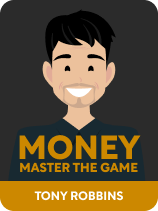

This article is an excerpt from the Shortform book guide to "Money: Master the Game" by Tony Robbins. Shortform has the world's best summaries and analyses of books you should be reading.
Like this article? Sign up for a free trial here .
Are you afraid of change? Do you want to know how to shift your mindset so you can live to your fullest potential?
In Money: Master the Game, Tony Robbins says that one of the reasons you might not be achieving your goals is because you have a limited mindset. While Robbins’ advice is in relation to finances, you can apply his three ways to shift your mindset to anything in life.
Continue reading to learn about shifting your mindset by taking control of your experience and using John Vervaeke’s model of knowledge to help.
Create Your Experience
To master anything in life, you need to learn how to shift your mindset: Robbins writes that, at any moment, your beliefs and emotions color how you perceive that experience, and they determine how you respond to it. For example, a man who’s convinced that all banks are untrustworthy will feel jaded and take little action to build his financial future.
(Shortform note: Robbins goes into more detail about how to change your mindset and behavior in Awaken the Giant Within with his six-step process of Neuro-Associative Conditioning. In short, you need to disrupt the old patterns—such as believing that investing is too hard and avoiding financial responsibility—and replace them with a new, empowering behavior and belief.)
To change your life, take conscious control of what you believe, how you feel, and how you act. Let’s look at the three ways to shift your limited mindset:
#1: What you believe: Robbins explains that your beliefs determine what you focus on. They’re habitual thoughts that cause you to interpret your experience through the “lens” of that thought—a filtering function of the reticular activating system (RAS), a key part of the brain. Then, they influence your experience in accord with what the belief emphasizes.
For instance, you might believe that work is a slog. So when you sit down each day, your mind will habitually pick out aspects of your experience that confirm that belief—such as daily aches and pains—and make you most aware of them. Then you think, “Ugh, another day of this,” and reinforce the belief—a positive feedback loop that will persist unless consciously broken.
#2: How you feel: Similarly, your emotions influence your thoughts and actions. If you feel lethargic, your thoughts and behaviors will likely also be sluggish and unmotivated. If you feel energized and confident, your mindset and actions will reflect that enthusiasm.
(Shortform note: In The Art of Learning, Josh Waitzkin suggests regulating your state by alternating periods of effort and rest. This draws from research on High-Intensity Interval Training (HIIT), which physiologists found can train the heart to swiftly shift between active and resting modes.)
#3: How you act: According to Robbins, the right thoughts are no use without the right strategy. To act effectively, start with theoretical knowledge—for example, knowing how to build wealth—and then take action. As you consistently implement a strategy, you gain practical knowledge and get emotionally committed to your goal.
Robbins asserts that each of us has already taken conscious control of these choices at some point in our lives. Think of past goals you achieved—whether making a high school sports team, getting into a good college, or landing a great job. In each case, you consciously chose to believe it was possible, you got emotionally attached to that outcome, and you took action to make it happen.
Using the Model of Knowledge to Shift Your Mindset
Robbins’s three-part model of mastery to shift your mindset—cognitive, emotional, and physical—is similar to John Vervaeke’s four-part model of knowledge. Vervaeke, a cognitive scientist, posits four Ps:
- Propositional knowing—theoretical knowledge, such as the ideas in this guide
- Procedural knowing—understanding a sequence of steps, like Robbin’s 7 Steps to Financial Freedom that are mentioned in Money: Master the Game
- Participatory knowing—the knowledge gained from doing, or tacit knowledge
- Perspectival knowing—the ability to take on other’s perspectives and see something as they do
Notice that each of these can help you learn how to shift your mindset: First, grasp Robbins’ arguments. Second, review any practical steps (procedures), and try them out to gain participatory knowledge. Finally, try putting yourself in the shoes of a top investor and imagine how they would think about and use these principles.

———End of Preview———
Like what you just read? Read the rest of the world's best book summary and analysis of Tony Robbins's "Money: Master the Game" at Shortform .
Here's what you'll find in our full Money: Master the Game summary :
- Tony Robbins’s approach to changing your money mindset and financial strategy
- Why money is not the end goal, but rather a tool
- Why you should play the long game rather than trying to get rich quick






